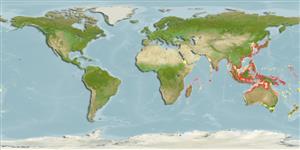Environment: milieu / climate zone / depth range / distribution range
ນິເວດວິທະຍາ
ສັດທະເລ; ນ້ຳກ່ອຍ ກ່ຽວກັນຫີນ; ລະດັບຄວາມເລິກ 5 - 40 m (Ref. 90102). Tropical
Western Pacific: Gulf of Thailand to southern Japan, Philippines (Ref. 9494), Borneo and Indonesia. Absent from New Guinea and Australia.
ຂະໜາດ / ນ້ຳໜັກ / Age
Maturity: Lm ? range ? - ? cm
Max length : 26.0 cm TL ຕົວຜູ້/ບໍ່ມີເພດ; (Ref. 90102); common length : 16.0 cm TL ຕົວຜູ້/ບໍ່ມີເພດ; (Ref. 9893); ນ້ຳໜັກສູງສຸດທີ່ເຄຍຈັດພີມມາ: 168.50 g (Ref. 124479)
ຄີຫຼັງຂອງປາ (ຄີອ່ອນ) (ທັງໝົດ) : 74 - 78; ຄີກົ້ນຂອງປາ: 65 - 68; ສັດທີ່ມີກະດູກສັນຫຼັງ: 51 - 52.
Inhabits shallow sand and mud bottoms of coastal waters. Feeds mainly on benthic invertebrates, especially small crustaceans. Marketed fresh, frozen, and dried-salted.
Life cycle and mating behavior
ການຈະເລີນເຕັມໄວ | ການສືບພັນ | ການວາງໄຂ່ | ໄຂ່ | ຄວາມດົກຂອງໄຂ່ປາ | ຕົວອ່ອນ
Munroe, T.A., 2001. Soleidae. Soles. p. 3878-3889. In K.E. Carpenter and V. Niem (eds.) FAO species identification guide for fishery purposes. The living marine resources of the Western Central Pacific. Vol. 6. Bony fishes part 4 (Labridae to Latimeriidae), estuarine crocodiles. FAO, Rome. (Ref. 9893)
IUCN Red List Status (Ref. 130435: Version 2024-1)
Threat to humans
Harmless
Human uses
ການປະມົງ: ເປັນສີນຄ້າ
ເຄື່ອງມື
Special reports
Download XML
ແຫຼ່ງອີນເຕີເນັດ
Estimates based on models
Preferred temperature (Ref.
123201): 21.3 - 29.1, mean 28.3 °C (based on 882 cells).
Phylogenetic diversity index (Ref.
82804): PD
50 = 0.5000 [Uniqueness, from 0.5 = low to 2.0 = high].
Bayesian length-weight: a=0.00794 (0.00492 - 0.01282), b=3.10 (2.96 - 3.24), in cm total length, based on LWR estimates for this species & (Sub)family-body (Ref.
93245).
ຊັ້ນເຂດຮ້ອນ (Ref.
69278): 3.5 ±0.50 se; based on food items.
ຄວາມຢືດຢຸ່ນ (Ref.
120179): ຂະໜາດກາງ, ປະຊາກອນຕຳ່ສຸດທີ່ໃຊ້ເວລາສອງເທົ່າ 1.4 - 4.4 ປີ (Preliminary K or Fecundity.).
Fishing Vulnerability (Ref.
59153): Low vulnerability (16 of 100).
